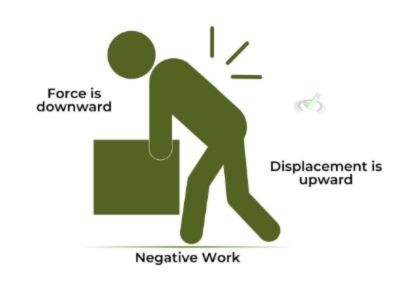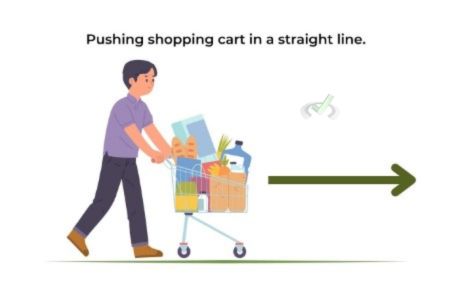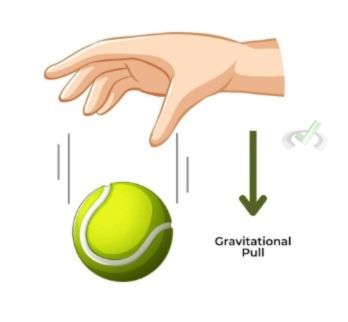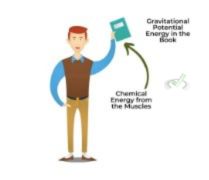Exploring the concept of work is fundamental in physics. Work is a crucial idea that helps explain how forces interact with objects to cause movement. This study note will explore what work means in physics, its properties, and how it applies to various situations.
I. Introduction to Work
Imagine pushing a toy car across the floor. When you push the car, you are doing work. In physics, work is done when a force causes an object to move in the direction of the force.
This means that the force you apply must make the object move for work to occur. If there's no movement, no work is done, even if you use a lot of force.
Definition of Work
Work is the product of the force applied to an object and the distance over which the force is applied. Mathematically, it can be expressed as:

Here, work is measured in joules (J), force in newtons (N), and distance in meters (m). For example, if you push a crate with a force of 10 N and it moves 2 meters, the work done is:

Requirements for Work
For work to be done, two conditions must be met:
- A force must be applied to an object.
- The object must move in the direction of the force.
For example, you are doing work if you push a box and it moves. However, if you push a wall and it doesn’t move, no work is done, even though you applied force. This distinction helps us understand that work in physics requires movement caused by a force.
II. Calculating Work
Let's look at a simple example to understand how to calculate work. If you push a crate with a force of 10 N and it moves 2 meters, the work done is:

Positive and Negative Work
Work can be positive or negative:
- Positive Work: When the force and the displacement are in the same direction. For instance, lifting a box upwards involves positive work because the force (upward) and the displacement (upward) are in the same direction.

- Negative Work: When the force and the displacement are in opposite directions. For example, lowering the box back to the floor involves negative work because the force (downward) and the displacement (upward) are in opposite directions.

Work Done by Friction
Friction is a force that opposes motion. When you move an object across a surface, friction does negative work because it acts in the opposite direction of the movement. For example, if you slide a book across a table, friction works against your push, making you do more work to keep the book moving.
III. Types of Work
There are different scenarios in which work is done. Understanding these can help identify how work operates in various contexts.
Work Done by Constant Force

When a constant force is applied, and the object moves in a straight line, calculating work is straightforward using the formula mentioned earlier. For example, pushing a shopping cart with constant force in a straight line.

Work Done by Variable Force
Calculating work becomes more complex when the force changes as the object moves. It involves integrating the force over the distance it acts. This is often seen in cases involving springs or gravitational fields.
For example, the force exerted by a spring changes as it is compressed or stretched. In this case, calculating work requires calculus, where the work done is the area under the force vs. displacement graph.
Work Done by Gravity

When an object is lifted or lowered in a gravitational field, gravity does work on the object. The work done by gravity is:

Where m is the object's mass (in kilograms), g is the acceleration due to gravity (approximately 9.8 m/s2 on Earth), and h is the height at which the object is moved. For example, lifting a 1 kg book to a shelf 2 meters high requires:

IV. Work-Energy Theorem
The work-energy theorem is an important principle that relates work to energy. It states that the work done on an object equals the change in its kinetic energy.
Moreover, kinetic energy is the energy an object has due to its motion. Mathematically, the work-energy theorem is expressed as:

Where ΔKE is the change in kinetic energy. This means that when you do work on an object, you change its energy. For example, when you push a car and it starts moving, the work you do on the car increases its kinetic energy.
V. Power and Work
Power is related to work. It measures how quickly work is done. The formula for power is:

Power is measured in watts (W). One watt equals one joule per second. For example, if you do 50 joules of work in 10 seconds, the power is:

VI. Applications of Work in Real Life
Understanding work helps explain many everyday activities. Here are a few examples:
Lifting Objects
When you lift a bag of groceries, you do work against gravity. The heavier the bag or the higher you lift it, the more work you do. For example, lifting a 10 kg bag 1 meter requires more work than lifting a 5 kg bag the same distance.
Using Machines
Machines, like cranes and pulleys, help us do work more efficiently. They can multiply the force we apply, allowing us to move heavier objects with less effort.
For example, a pulley system can help lift a heavy load with less force than lifting it directly. This is because pulleys change the direction of the force and can distribute the load.
Moving Vehicles
Engines in cars do work to move the vehicle. The fuel consumed by the engine provides the energy needed to do this work.
When the fuel burns, it releases energy that powers the engine, moving the car forward. This conversion of chemical energy in the fuel to mechanical energy moves the car.
VII. From Work to Energy and Efficiency
Understanding work leads to exploring other important physics concepts such as energy, efficiency, and mechanical advantage. Work and energy are closely linked, as doing work on an object transfers energy to it.

Energy
Energy is the capacity to do work. When work is done, energy is transferred or transformed from one form to another.
For example, when you work to lift a book, you transfer chemical energy from your muscles to gravitational potential energy in the book.
Efficiency
Efficiency measures how well energy is converted into useful work. It is expressed as a percentage and calculated by comparing the work output to the energy input.
Higher efficiency means less energy is wasted. For example, an efficient car engine converts more fuel energy into motion and less into heat.
Mechanical Advantage
The factor that a machine multiplies the force applied to it is called mechanical advantage. It helps us understand how tools and machines make work easier by allowing us to use less force over a greater distance. For example, a lever will enable us to lift a heavy load with less force by increasing the distance over which the force is applied.
VIII. Wrap-Up and Key Terms
Let's review the key points we covered about work:
Key Terms
- Work: The product of force and distance, measured in joules (J).
- Force: A push or pull on an object, measured in newtons (N).
- Distance: The length over which the force is applied, measured in meters (m).
- Power: The rate at which work is done, measured in watts (W).
- Friction: A force that opposes motion, doing negative work.
- Work-Energy Theorem: The principle that work done on an object equals the change in its kinetic energy.
IX. Practice Questions
Sample Practice Question 1
What is the work done when a force of 15 N moves an object 3 meters?
A. 30 J
B. 45 J
C. 60 J
D. 75 J
Ans. B
Work is calculated as Force×Distance=15 N×3 m=45 J
Sample Practice Question 2
What is their power output if a person does 100 J of work in 20 seconds?
A. 2 W
B. 4 W
C. 5 W
D. 10 W
Ans. C
Power is calculated as Work/Time=100 J/20 s=5 W







 To help you achieve your goal MCAT score, we take turns hosting these
To help you achieve your goal MCAT score, we take turns hosting these 





















 reviews on TrustPilot
reviews on TrustPilot